n16
![]()
Have done many experiments with Mini Circuits ringmixer
SRA-1H. It is a highlevel mixer with 50mW LO power.

Here is the hole circuit. RF port and IF port is terminated in 50
ohm broadband termination. 3rd order IP on mixer input was ca
+27.5dBm

Here the mixer is terminated in a series resonnance circuit on
the input and a narrowband (50ohm) termination with xtal filter
on the output. The IP3 has dropped to 12.5dBm, mainly because of
the bad IF port termination, RF port is not so critical although
it is wrongly terminated
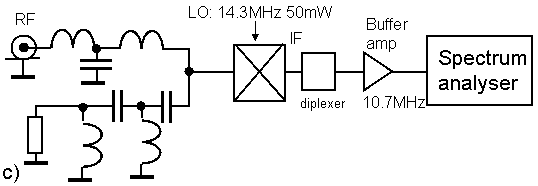
Here the input is couplet via an input dividing filter, and the
output is correct terminated via a 50 ohm amplifier to the the
spectrum analyser and the IP3 is still +27.5sBm. On the mixer
output it is important to use correct termination. Tried the same
method as for CDG2000 (Radcom summer 2002), diplexer and 90°
hybrid. It looks promissing, but after the hybrid two equal xtal
filters are required. Between the diplexer and 90° I have tested
the amplifier with two transformers. It has good dynamic and can
handle the output signal from the mixer without reducing the IP3.
(LA7MI)
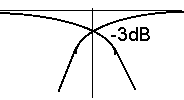
Input filter curve, -3dB @ 18MHz for each leg
To make these experiments you need a two-tone generator and a spectrum analyser, more constructional details are shown below
Highlevel IF buffer
for several purposes (LA7MI)
In the book written by William Sabin og Edgar O. Schoenike
"Single.sideband systems & Circuits" from 1987 is
shown a circuit with good dynamic and low noise. The book was
publisched in 1987 .
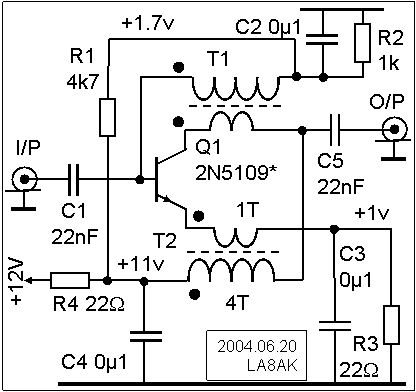 |
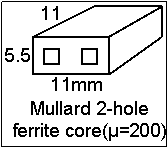 |
The most suitable device is 2N5109 with 50mA collector current-
Have suggested component values for 1-30MHz. The transformer
winding ratios decides amplification and input impedance. It was
tested with 1:4 for both transformers, it was found suitable for
50 ohm impedance and 12dB gain. LA7MI used a Mullard two-hole
core - bought as surplus from Birkett in England, permittivity
was measured to µ=180. The polarity is very important, otherwise
you'll make an oscillator. It was quite tricky to do it right! He
believes it is better to use a two-hole core than standard toroid
core for good coupling between the windings. (LA7MI)
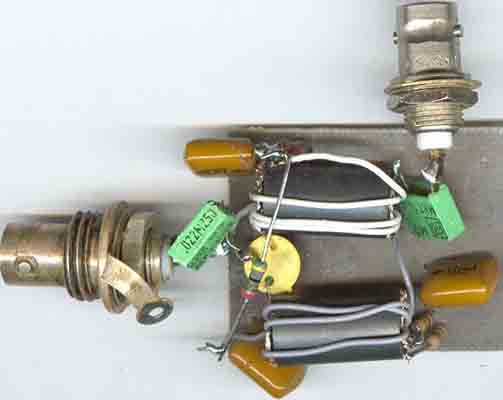
Wanted to test the amplifier with a different toroid than what
was already described. Couldn't find any 2N5109, and the 2N3866's
were surplus and regarded as unreliable, so I used 2N4427. Also
used some low-performance capacitors. Gain is 12dB, it drops 1dB
@55MHz. The current gain for 2N4427 seem somewhat low for 50mA
current. The toroids are Philips 3122 134 90783 (ferrite grade
4A4 permeability 500) with RG58/U braid used for the single
winding to achieve sufficient coupling. See page n12. It was somewhat difficult to solder the
transformers the right way around, and smaller cores or beads
would have been an advantage. The problem with this circuit is
somewhat high return gain, suppose it is better for W4ZCB's
Zwischenbasis amplifier described on page c19, but
should be of lesser importance according to LA7MI. ((LA8AK))
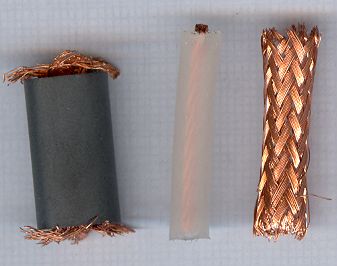
My comments about RF transformers where it is one turn consisting
of a brass tube, is this really neccessary, could a coax braid be
used just as well?
The ends could be soldered together, and you need no end plates
(LA8AK)
Redifon high-level mixer
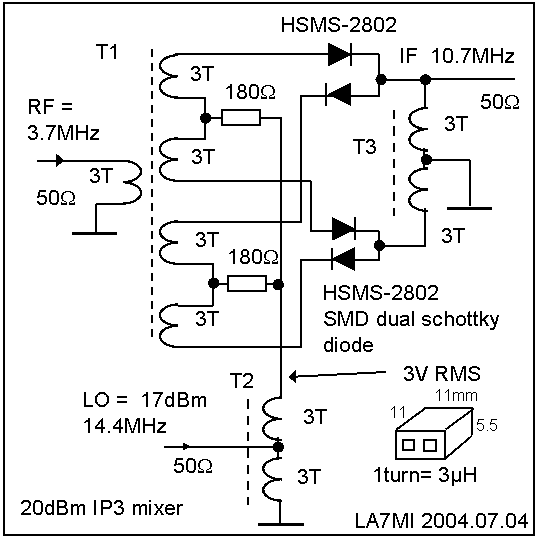
LA7MI Stein Torp writes that he has tested a mixer which was used
in a Redifon (GR-345) mobile transceiver - advertized in Wireless
World in 1965, but used sort of modern components. The diodes in
the construction shown are smd version matched twin 2800. The
input transformer is a pentofilar wound type with 5x 3turns
(0.25mm enam cu wire), see drawing for the type of Mullard two
hole core used in the transformers (µ=200, sold by Birkett).T2
and T3 are wound with 2x 3turns 0.3mm wire. With input on 80m and
10.7MHz IF (LO = 14.5MHz) 3rd order IP on the input was measured
to +20dB, and the strange is that output termination is not
critical at all. It is possible to terminate it with an xtal
filter and still obtain +20dBm, which is not at all possible with
a ringmodulator. Measured the 1dB compression point to +10dBm.
With some more LO excitation it is possible to increase the IP3
above +35dBm, see the notes below.
Diode-pairs (Ferranti ZC5800) and transformers in the original
version seems to have been building blocks manufactured by Hugh
Aircraft Corp., but the component designations does not make
sense.
This mixer is also mentioned by G3RZP Peter Chadwick in ART6
(written by G3VA) pp131-132 and ART7 pp140, but two diodes are
incorrectly drawn, and he doesn't mention that the mixer is not
sensitive for termination impedance.
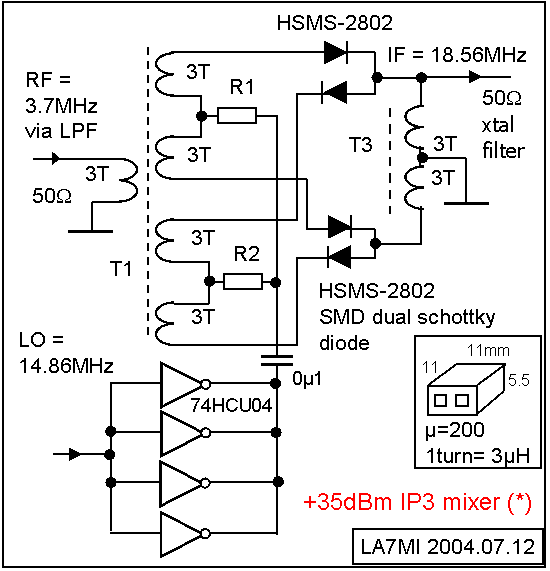
Changing the oscillator drive circuit to 74HCU04 the IP3
increases to +25dBm. But the diodes may be driven even harder, so
R1 and R2 are reduced to 120 ohm and IP3 increases to +30dBm.
At last he thought it was worth it to try to increase the voltage
for 74HCU04 to 7V, hoping that the manufacturer's data could be
forced up a few volts, and the IP3 increased to +35dBm. It is no
problem using an xtal filter at the output (see the note for
18.558MHz xtal filter below), but it seems to be an advantage
with a lowpassfilter on the input, with lower impedance on the
higher frequencies, all this would totally spoil the performance
of an ordinary ringmixer.
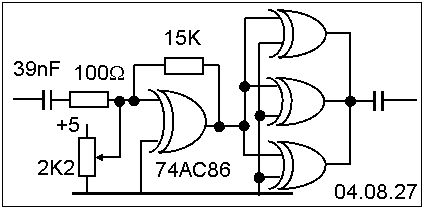
An improved buffer which also can adjust symmetri of oscillator
signal to minimize LO leakage
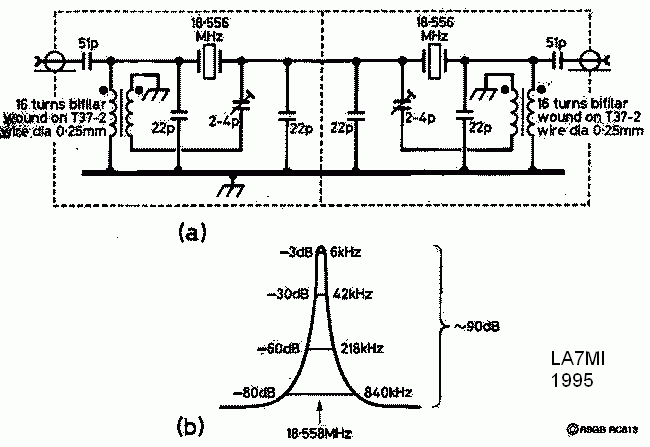
The 18.556MHz crystal ladder filter is shown in Radcom, Technical
topics Dec. 95 pg 71.
See constructional details and more xtal filters on page n23
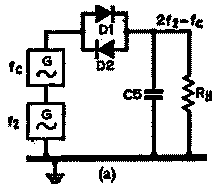
Reference: RA3AAE anti-paralell diode mixer (harmonic
mixer/product detector with diode pair) on page c21
Most topics are received in letters from LA7MI.
He has a soldering iron, but no email, and is reached by
telephone nr +47-55-902392.
He will be very pleased to receive
comments, the postal address is: LA7MI Stein Torp,
Tollbodalmenning 34, N-5005 Bergen, Norway
Last update: 2004.10.26